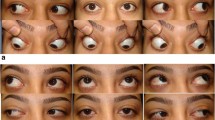Abstract
Purpose
The aim of this study is to evaluate the incidence of consecutive strabismus after infantile nystagmus surgery and its potential risk factors.
Methods
A retrospective study including 89 patients was conducted. Patients presented infantile nystagmus (idiopathic or ocular disease–associated nystagmus) without previous or coincidental strabismus. Sex, age at surgery, amblyopia, botulinum toxin (BT) injection before surgery, spherical equivalent, anisometropia, surgery procedure (Anderson’s or retroequatorial recessions of four horizontal recti), and follow-up were analyzed. Kaplan-Meier and univariate Cox regression were performed.
Results
The median age at surgery was 5 years. The median follow-up was 36 months. The incidence of consecutive strabismus was 11.2%. There were eight patients with exotropia and two patients with esotropia. Consecutive strabismus was associated with severe bilateral amblyopia (p = 0.036), previous treatment with BT injection (p = 0.025), and large recessions of the four horizontal muscles (p = 0.001). The hazard ratio for patients with severe bilateral amblyopia was 5.4 (95% CI 1.1–25.8), and for patients previously treated with BT was 6.1 (1.3–29.3). The survival rate was 95.4% at 6 months and 88.5% at 3 years.
Conclusion
Severe bilateral amblyopia, previous BT treatment, and type of surgery seem to be associated with consecutive strabismus after infantile nystagmus surgery. Most cases appear within the first months after surgery.


Similar content being viewed by others
References
Nash D, Diehl N, Mohney B (2017) Incidence and types of pediatric nystagmus. Am J Ophthalmol 182:31–34. https://doi.org/10.1016/j.ajo.2017.07.006
Ehrt O (2012) Infantile and acquired nystagmus in childhood. Eur J Paediatr Neurol 16:567–572. https://doi.org/10.1016/j.ejpn.2012.02.010
Hertle R (2000) Examination and refractive management of patients with nystagmus. Surv Ophthalmol 45:215–222
Abadi R, Bjerre A (2002) Motor and sensory characteristics of infantile nystagmus. Br J Ophthalmol 86:1152–1160
Brodsky M, Fray K (1997) The prevalence of strabismus in congenital nystagmus: the influence of anterior visual pathway disease. J AAPOS 1:16–19
Hertle RW (2008) Nystagmus in infancy and childhood. Semin Ophthalmol 23:307–317. https://doi.org/10.1080/08820530802505955
Alió J, Chipont E, Mulet E, De La Hoz F (2003) Visual performance after congenital nystagmus surgery using extended hang back recession of the four horizontal rectus muscles. Eur J Ophthalmol 13:415–423
Boyle N, Dawson E, Lee J (2006) Benefits of retroequatorial four horizontal muscle recession surgery in congenital idiopathic nystagmus in adults. J AAPOS 10:404–408
Kang N, Isenberg S (2009) Kestenbaum procedure with posterior fixation suture for anomalous head posture in infantile nystagmus. Graefes Arch Clin Exp Ophthalmol 247:981–987. https://doi.org/10.1007/s00417-009-1037-2
Bagheri A, Farahi A, Yazdani S (2005) The effect of bilateral horizontal rectus recession on visual acuity, ocular deviation or head posture in patients with nystagmus. J AAPOS 9:433–437
Singh A, Ashar J, Sharma P et al (2016) A prospective evaluation of retroequatorial recession of horizontal rectus muscles and Hertle-Dell’Osso tenotomy procedure in patients with infantile nystagmus with no definite null position. J AAPOS 20:96–99. https://doi.org/10.1016/j.jaapos.2015.10.021
Folk E, Miller M, Chapman L (1983) Consecutive exotropia following surgery. Br J Ophthalmol 67:546–548
Shauly Y, Prager T, Mazow M (1994) Clinical characteristics and long-term postoperative results of infantile esotropia. Am J Ophthalmol 117:183–189
Trigler L, Siatkowski R (2002) Factors associated with horizontal reoperation in infantile esotropia. J AAPOS 6:15–20
Ganesh A, Pirouznia S, Ganguly S et al (2011) Consecutive exotropia after surgical treatment of childhood esotropia: a 40-year follow-up study. Acta Ophthalmol 89:691–695
Yurdakul N, Ugurlu S (2013) Analysis of risk factors for consecutive exotropia and review of the literature. J Pediatr Ophthalmol Strabismus 50:268–273. https://doi.org/10.3928/01913913-20130430-01
Han S, Han J, Rhiu S et al (2016) Risk factors for consecutive exotropia after esotropia surgery. Jpn J Ophthalmol 60:333–340. https://doi.org/10.1007/s10384-016-0443-3
Oh S, Park K, Oh S (2018) Comparison of recurrent esotropia and consecutive exotropia with horizontal muscle reoperation in infantile esotropia. Jpn J Ophthalmol 62:693–698. https://doi.org/10.1007/s10384-018-0629-y
Anderson J (1953) Causes and treatment of congenital eccentric nystagmus. Br J Ophthalmol 37:267–272
Bietti G, Bagolini B (1960) Traitement medicochirurgical du nystagmus. Année Ther Clin Ophtalmol 11:269–296
Arroyo-Yllanes M, Fonte-Vázquez A, Pérez-Pérez J (2002) Modified Anderson procedure for correcting abnormal mixed head position in nystagmus. Br J Ophthalmol 86:267–269
Gupta R, Sharma P, Menon V (2006) A prospective clinical evaluation of augmented Anderson procedure for idiopathic infantile nystagmus. J AAPOS 10:312–317
Abbruzzese G, Berardelli A (2006) Neurophysiological effects of botulinum toxin type a. Neurotox Res 9:109–114
Mathevon L, Michel F, Decavel P et al (2015) Muscle structure and stiffness assessment after botulinum toxin type A injection. A systematic review. Ann Phys Rehabil Med 58:343–350. https://doi.org/10.1016/j.rehab.2015.06.002
Bryselbout S, Promelle V, Pracca F, Milazzo S (2018) Clinical and surgical risk factors for consecutive exotropia. Eur J Ophthalmol 1:33–37. https://doi.org/10.1177/1120672118769787
Bradbury J, Doran R (1993) Secondary exotropia: a retrospective analysis of matched cases. J Pediatr Ophthalmol Strabismus 30:163–166
Chung A, Rehman S, Bradbury J (2005) Comparison of modified anchored “hang-back technique HBT)” with conventional HBT in bimedial rectus recession. J AAPOS 9:234–239
Author information
Authors and Affiliations
Corresponding author
Ethics declarations
Conflict of interest
The authors declare that they have no conflict of interest.
Ethical approval
All procedures performed in the study were in accordance with the ethical standards of Institutional Research Ethics Committee of Ramón y Cajal University Hospital and with the 1964 Helsinki declaration and its later amendments or comparable ethical standards. Due to the retrospective nature of the study, informed consent was not required.
Additional information
Publisher’s note
Springer Nature remains neutral with regard to jurisdictional claims in published maps and institutional affiliations.
Rights and permissions
About this article
Cite this article
Gómez-Mariscal, M., Hernández-Martínez, P., Rodríguez-del Valle, J.M. et al. Consecutive strabismus after infantile nystagmus syndrome surgery and potential risk factors. Graefes Arch Clin Exp Ophthalmol 258, 1549–1554 (2020). https://doi.org/10.1007/s00417-020-04686-9
Received:
Revised:
Accepted:
Published:
Issue Date:
DOI: https://doi.org/10.1007/s00417-020-04686-9



